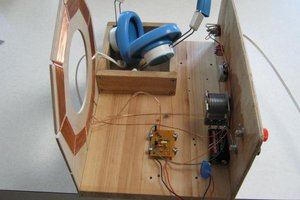These are complete building instructionsfor a 433 MHz microsized UHF spy audio transmitter. See video below:
First make sure you have the following tools/materials:
- solder paste
- fine tip soldering iron
- thin solder wire
- fine tweezers
- a clean workplace
- a piece of wire for the antenna
All the other parts are in the BOM you can find here:
https://drive.google.com/drive/folders/1JNk8aRTEaHpzyF5zj-TSWnToqcC0iQIX
Explaining the attached PDF schematic (see below):
To the left is the microphone, the audio signal is capacitively coupled to a very simple amplifier stage and then goes to a varactor diode that modulates the HF oscillator.
The oscillator to the right is basically a simple SAW based oscillator that's being "disturbed" by our low frequency audio signal.
Keep in mind that in order for the circuit to be as small as possible the component count had to be kept as low as possible too, so what you see here is really the bare minimum needed for the intended purpose.
The parts are almost all 0201 packages for the passive components, they are much easier to assemble than the ones from my first instructable that used 01005 packages.
Power output can be increased dramatically if R1 is lowered, I tested it down to a 100 Ohm or so a while ago. Current will increase accordingly though, from 1mA with 620 Ohm to a couple of mA with lower R1 value.
Power could even be further increase by increasing the power supply voltage to let's say 3V. The microphone is good for 1.45V only though so you would need to find a way to protect it. Better stick to 1.5V :-)
If any modifications are done, like board thickness or copper trace thickness or even the SAW frequency the inductor value will need to be readjusted. This can be cumbersome but up to 433MHz is certainly doable.
First you need the PCB. Download the gerber.zip file or the .brd file from the google drive folder.
Then go to Oshpark.com and upload the gerber.zip or .brd file, choose 0.8mm 2oz, pay and wait until it's delivered.
Download the BOM from the google drive folder and go to digikey.com. Find all the parts as explained in the Youtube video.
Pay, wait until delivery and you are good to go.
Assembly
Download the EAGLE Light (free) version to visualize the board layout or refer to the board screenshot here.
- Put some solder paste on each pad with the help of a needle or similar.
- Place all components according to the .brd layout file.
- Heat to 250 degree celsius and remove the heat as soon as the solder paste melted.
- Solder the antenna wire
Receiver
If you don't have a receiver get a cheap dongle from here:
https://www.rtl-sdr.com/buy-rtl-sdr-dvb-t-dongles/
You can find free software for PC here:
https://www.rtl-sdr.com/big-list-rtl-sdr-supported-software/
OR download a compatible app from the Android store, I used RF analyzer, for a few dollars.
https://play.google.com/store/apps/details?id=com.mantz_it.rfanalyzer&hl=en
Your phone will need to have OTG support because the dongle is powered by the phone.
That's it . Happy building





 ElectronicABC
ElectronicABC
 agp.cooper
agp.cooper
 Sagar 001
Sagar 001
I want to download the schema of this project. Tell me, please, why I can't do it? Could you fix this link?